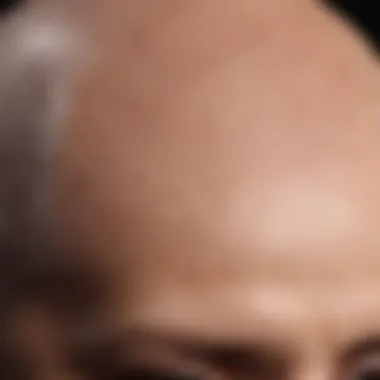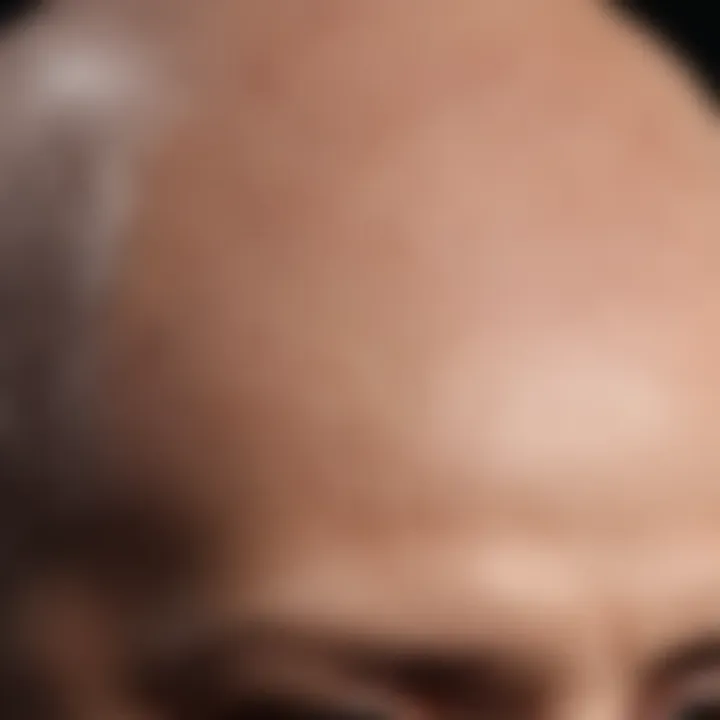Advanced Androgenetic Alopecia: Insights and Treatments


Article Overview
Purpose of the Article
This article examines the complexities surrounding advanced androgenetic alopecia. By focusing on its genetic underpinnings, physical manifestations, and management strategies, we aim to provide a comprehensive guide for students, researchers, and healthcare professionals. Understanding this condition is crucial because it affects a significant portion of the population, leading to psychological and social implications. Our intention is to present an informed perspective that can stimulate further research and enhance clinical practices.
Relevance to Multiple Disciplines
The study of advanced androgenetic alopecia connects multiple fields, including dermatology, genetics, psychology, and even sociology. Hair loss can influence self-image and mental health, making it relevant in clinical psychology as well. Moreover, the management of this condition demands a collaborative approach, integrating knowledge from various disciplines. This multifaceted nature makes the topic compelling for a diverse audience, from healthcare practitioners to researchers in genetics.
Research Background
Historical Context
Androgenetic alopecia has been documented for centuries, with literature referencing hair loss in ancient texts. The formal recognition of this condition, however, emerged prominently in the 20th century when dermatologists began observing patterns of hair loss related to genetic predisposition. Since then, research has evolved, bringing forth an understanding of the biological mechanisms involved.
Key Concepts and Definitions
To grasp the nuances of advanced androgenetic alopecia, it is essential to define some basic concepts:
- Androgenetic Alopecia: A hereditary condition causing hair loss in a predictable pattern, usually influencing frontal and vertex areas.
- Etiology: The specific causes underlying the condition, primarily linked to hormonal influences and genetic factors.
- Pathophysiology: Refers to the biological processes that contribute to hair follicle miniaturization and hair thinning.
Understanding these terms creates a foundation for discussing the clinical presentation, diagnosis, and treatment options available for this condition.
"Advanced androgenetic alopecia is not merely a cosmetic concern; it is a condition deeply entwined with individual identity and health."
"Advanced androgenetic alopecia is not merely a cosmetic concern; it is a condition deeply entwined with individual identity and health."
By establishing a core understanding of advanced androgenetic alopecia, this article will delve deeper into its manifestations, how it affects individuals across different demographics, and explore contemporary treatment strategies that aim to alleviate this common yet complex condition.
Prelude to Advanced Androgenetic Alopecia
Advanced androgenetic alopecia represents a significant concern for many individuals, impacting self-esteem and social interactions. Its understanding is crucial for both clinical practice and research. Hair loss, particularly in its advanced stages, sends ripples through one’s identity and mental health. By delving deep into this condition, we not only illuminate its nature but also the implications it has for those affected.
Definition
Advanced androgenetic alopecia is a progressive form of hair loss that affects both men and women. It is characterized by a pattern of thinning hair, often leading to noticeable bald areas. This condition is genetically predetermined, meaning that the likelihood of its occurrence often runs in families. It is important to recognize that this condition can manifest differently in each gender, leading to distinct patterns and degrees of hair loss. The involvement of androgens, particularly in genetic susceptibility, plays a key role in this alopecia’s onset and progression.
Epidemiology
The prevalence of advanced androgenetic alopecia varies significantly across different populations and genders. Statistically, about 50% of men experience some degree of hair loss by the age of 50, while women may also face substantial thinning, especially after menopause. The global perspective highlights variances among ethnic groups, with Caucasian populations typically exhibiting higher rates of androgenetic alopecia than Asian or African populations.
- Male-Specific Rates: Higher percentages of men are visibly affected by this condition. It is common for young men to begin noticing hair thinning in their late teens to early twenties.
- Female-Specific Rates: Women often experience a different onset pattern, with hair loss beginning closer to middle age. The impact of hormonal changes associated with aging, particularly post-menopause, also affects hair density and growth.
Understanding the epidemiology of advanced androgenetic alopecia informs both clinicians and researchers about the demographic trends. Such insights are vital for developing targeted treatments and awareness campaigns that address the unique needs of those affected.
"A comprehensive grasp of the demographic factors integral to advanced androgenetic alopecia facilitates improved patient care and targeted therapies at various stages of the condition."
"A comprehensive grasp of the demographic factors integral to advanced androgenetic alopecia facilitates improved patient care and targeted therapies at various stages of the condition."
Etiology of Advanced Androgenetic Alopecia
Understanding the etiology of advanced androgenetic alopecia is crucial because it lays the foundation for diagnosis, prognosis, and treatment strategies. The interplay between genetic and hormonal factors provides insights into this condition's underlying mechanisms. A comprehensive grasp of these elements helps professionals develop targeted interventions and supports individuals in coping effectively with hair loss.
Genetic Factors
Genetic predisposition is a major contributor to advanced androgenetic alopecia. Research shows that this condition runs in families, hinting at a hereditary component. Specific genes, such as the androgen receptor (AR) gene, have been linked to increased sensitivity to hormones that affect hair follicles. This genetic influence accounts for variability in hair loss patterns among individuals. Thus, genetic testing may help in assessing risk and tailoring treatments for patients.
Hormonal Influences
Hormonal factors play a significant role in the development and progression of advanced androgenetic alopecia. The primary player in this dynamic is dihydrotestosterone (DHT).
Role of Dihydrotestosterone
DHT is a potent androgen derived from testosterone. Its role in androgenetic alopecia is well-documented, as it binds to androgen receptors in hair follicles, causing them to shrink. This process, known as follicular miniaturization, leads to shorter hair cycles and eventually results in hair loss. The increase in DHT levels in scalp tissues correlates with the severity of hair thinning.
Moreover, DHT's influence extends beyond genetics. Research indicates that individuals with higher DHT levels often experience more pronounced hair loss. This relationship establishes DHT as a focal point for therapeutic approaches.
Impacts of Androgens
Androgens, including testosterone and its metabolites, can contribute to advanced androgenetic alopecia. They affect not only hair follicles but also sebaceous glands, altering oil production and potentially leading to scalp inflammation. Androgens influence the entire hair growth cycle, pushing hair into resting phases prematurely.


The dysregulation of androgens further complicates the picture. While a balanced level is essential for various bodily functions, excess androgens can exacerbate hair loss. Understanding the broad impacts of androgens is valuable for developing holistic treatment strategies.
Hormonal influences on hair loss underscore the necessity for a tailored approach in managing advanced androgenetic alopecia.
Hormonal influences on hair loss underscore the necessity for a tailored approach in managing advanced androgenetic alopecia.
Pathophysiology of Advanced Androgenetic Alopecia
The pathophysiology of advanced androgenetic alopecia (AGA) is crucial for understanding its complexity and implications. This section explores how biological processes contribute to hair loss, highlighting the importance of recognizing these factors for effective treatment strategies. Understanding the pathophysiology can lead to better therapeutic targets and enhance the overall management of the condition.
Follicular Miniaturization
One of the key processes in advanced androgenetic alopecia involves follicular miniaturization. This phenomenon refers to the progressive shrinkage of hair follicles, which results in thinner and weaker hair strands. Over time, miniaturized follicles produce hair that is increasingly fine, ultimately leading to substantial hair loss.
The cycle of hair growth undergoes significant alteration in AGA. The anagen (growth) phase shortens while the telogen (resting) phase extends. This shift leads to an imbalance in hair growth, with fewer hairs entering the growth phase and more shedding. Genetic predisposition plays a crucial role here, as specific genes may increase the susceptibility to this miniaturization process.
Research has shown that individuals with advanced androgenetic alopecia experience higher levels of androgens, particularly dihydrotestosterone (DHT), within their scalp tissue. DHT binds to androgen receptors in hair follicles, triggering several cellular pathways that ultimately lead to miniaturization. This response is particularly pronounced in genetically predisposed individuals, making the study of these mechanisms essential for designing effective interventions.
Scalp Inflammation
Another significant aspect of AGA involves scalp inflammation. Inflammation can exacerbate hair loss, creating a harmful cycle that impedes recovery and restoration. In many cases, inflammation accompanies the miniaturization process, weakening the hair follicles even further. The immune response can be triggered by various factors, including changes in the microenvironment of the scalp, skin conditions, or even stress.
Several studies suggest a correlation between inflammatory mediators and hair loss. Elevated levels of cytokines and other inflammatory markers have been observed in the scalp of individuals suffering from advanced androgenetic alopecia. The inflammation may lead to disruptions in normal hair follicle cycling, promoting further miniaturization and aggravating hair loss.
Understanding these underlying processes is essential in developing targeted therapies.
Understanding these underlying processes is essential in developing targeted therapies.
Clinicians and researchers need to focus on not just the symptoms of hair loss but also the underlying pathophysiological mechanisms, such as follicular miniaturization and inflammation. Integrating this knowledge into treatment frameworks can foster more effective management strategies, paving the way for interventions that address the root causes of advanced androgenetic alopecia.
Clinical Presentation
The clinical presentation of advanced androgenetic alopecia is significant for several reasons. It is the manifestation of the condition that both patients and healthcare professionals can observe. Understanding these patterns and symptoms aids in diagnosing the condition accurately. Moreover, a clear grasp of the clinical presentation assists in formulating tailored management strategies. This section will discuss the various patterns of hair loss observed in males and females, as well as associated symptoms that further characterize this complex disorder.
Patterns of Hair Loss
The patterns of hair loss are crucial factors in understanding advanced androgenetic alopecia. They vary significantly between genders and reflect genetic predispositions. In addition, identifying these patterns can streamline the diagnostic process, facilitating appropriate interventions.
Male-Specific Patterns
Male-specific patterns of hair loss are typically characterized by a receding hairline and thinning at the crown. This pattern is often described using the Hamilton-Norwood scale. The early stages involve a subtle recession at the temples, which can progress to a more pronounced balding crown.
Key characteristics of this pattern include:
- Temporal recession: The hairline recedes at the temples.
- Crown baldness: Thinning or bald spots may develop at the top of the head.
These patterns are beneficial to this article because they highlight the genetic nature of the disorder. Understanding how these specific patterns relate to genetics is crucial. One unique feature of male-pattern hair loss is the progressive nature, going from mild thinning to complete baldness, depending on individual genetics and hormone levels.
Advantages of focusing on male-specific patterns include effective communication with patients and providing clear treatment options that can address their concerns. However, these distinct patterns can lead to emotional distress, influencing mental health in affected individuals.
Female-Specific Patterns
Female-specific patterns can be more diffuse and less predictable than male patterns. Women often exhibit overall thinning, particularly at the crown, but the frontal hairline usually remains intact. This distinguishes female-pattern hair loss from male patterns.
Key characteristics include:
- Diffuse thinning: Hair loss is spread across the scalp rather than localized.
- Retention of hairline: Unlike men, women typically do not experience a receding hairline.
This pattern is worth exploring as it develops differently, emphasizing the necessity for tailored treatment approaches. A unique feature of female-specific patterns is that the loss may be subtler, leading to underdiagnosis or delayed treatment.
Advantages of recognizing female-specific patterns lie in increasing awareness about women's experiences with hair loss. However, the challenge remains in that these patterns often lead to significant distress and anxiety.
Associated Symptoms
Beyond hair loss, associated symptoms can further complicate the clinical picture of advanced androgenetic alopecia. Patients may experience varying degrees of emotional distress, which can impact their quality of life. Some common symptoms include:
- Itching or irritation on the scalp: Often a result of inflammation.
- Reduced self-esteem: Hair loss can lead to a diminished sense of identity.
- Difficulties in social situations: Individuals may avoid social interactions due to embarrassment or shame.
The interplay between physical symptoms and emotional response can create a complex scenario for individuals facing advanced androgenetic alopecia. Addressing these associated symptoms is crucial for comprehensive management and improving patient outcomes.
Diagnosis of Advanced Androgenetic Alopecia
Diagnosing advanced androgenetic alopecia (AGA) is crucial in the management and treatment of this condition. An accurate diagnosis not only assists in identifying the type and severity of hair loss but also helps in tailoring appropriate intervention strategies. This section will outline the clinical assessment methods and diagnostic tools relevant to diagnosing AGA.


Clinical Assessment
Clinical assessment is often the first step in diagnosing advanced androgenetic alopecia. Health professionals typically start with a detailed patient history and physical examination. It involves determining the onset and progression of hair loss, family history of similar issues, and any associated symptoms experienced by the patient.
The physician assesses the pattern of hair loss, which can differ significantly between males and females. For men, the Norwood scale is frequently used, while the Ludwig scale generally applies to women. Factors such as scalp health, previous treatments, and underlying medical conditions may also be evaluated. This thorough assessment provides a foundation for further diagnostic testing if necessary.
Diagnostic Tools
In addition to clinical assessment, various diagnostic tools are employed to confirm the diagnosis of advanced androgenetic alopecia. Two principal methodologies used in practice are trichoscopy and scalp biopsy.
Trichoscopy
Trichoscopy is a non-invasive technique that utilizes a dermatoscope to examine the scalp and hair follicles. It provides a clear view of the hair and scalp, allowing for detailed observation of hair thickness, density, and follicle health. One of the key characteristics of trichoscopy is its ability to visualize the_pattern_of hair loss in real-time.
This method is beneficial in many ways:
- It is painless and quick, making it a patient-friendly option.
- It allows for immediate assessment without the need for a biopsy.
- Trichoscopy can distinguish between androgenetic alopecia and other types of hair loss, like scarring alopecia.
However, trichoscopy does have limitations. It requires skilled personnel to interpret the images accurately, and misinterpretation can lead to incorrect diagnoses. Still, its advantages make it a popular choice in clinical practices.
Scalp Biopsy
Scalp biopsy is another valuable tool for diagnosing advanced androgenetic alopecia. This procedure involves extracting a small sample of scalp tissue for histological analysis. One of the significant advantages of a scalp biopsy is its ability to provide definitive information about the hair follicles and surrounding tissues.
Here are the core features of scalp biopsy:
- It helps in differentiating between various types of alopecia,
- Offers insights into inflammation or scarring, which could indicate other underlying conditions.
- Provides definitive diagnosis when trichoscopy is inconclusive.
Nonetheless, scalp biopsy is an invasive procedure and may cause discomfort or scarring in some patients. It also requires specialized laboratory facilities for analysis. Despite these disadvantages, its contribution to accurate diagnosis cannot be understated.
In summary, the diagnosis of advanced androgenetic alopecia involves a combination of clinical assessments and advanced diagnostic tools. Through a structured approach utilizing trichoscopy and scalp biopsy, practitioners can effectively determine the presence and progression of AGA, paving the way for judicial management strategies.
Management Strategies
The management of advanced androgenetic alopecia is a multifaceted approach that requires careful consideration of various treatment options. The objective is to provide effective solutions that address the complex nature of hair loss. The selection of management strategies plays a crucial role in improving the quality of life for those affected. It is necessary to combine both medical and surgical options to achieve the best results.
Medical Treatments
Minoxidil
Minoxidil is a topical treatment commonly used to promote hair regrowth in individuals suffering from advanced androgenetic alopecia. One key characteristic of minoxidil is its ability to increase blood flow to hair follicles, which helps nourish them and stimulate hair growth. This makes it a popular choice, especially among women.
A unique feature of minoxidil is that it is available in both liquid and foam forms, allowing patients to choose what works best for their lifestyle. However, it is important to note that the use of minoxidil may have side effects, such as scalp irritation or unwanted facial hair growth. It takes continuous use of minoxidil to maintain results, which can be a consideration for some patients.
Finasteride
Finasteride is an oral medication that inhibits the conversion of testosterone to dihydrotestosterone (DHT), a hormone involved in hair loss. This makes finasteride a valuable treatment option for men dealing with androgenetic alopecia. One significant characteristic of finasteride is its effectiveness in promoting hair regrowth.
A unique feature is that it often shows results within a few months, making it a quick option for many individuals. However, finasteride does come with potential side effects, including sexual dysfunction and gynecomastia, which can deter some patients. Also, discontinuation of the medication typically leads to a loss of any regrowth.
Surgical Interventions
Hair Transplantation
Hair transplantation is a surgical procedure that moves hair follicles from a donor site to areas experiencing hair loss. This method can provide permanent results and is effective for both men and women. One of the key characteristics of hair transplantation is its ability to create natural-looking hair lines.
A significant feature is that it allows patients to regain lost confidence. On the downside, hair transplantation involves a lengthy recovery period and can be quite expensive. Additionally, results can vary based on the skill of the surgeon and the patient's individual hair characteristics.
Aesthetic Procedures
Aesthetic procedures, such as scalp micropigmentation, offer non-invasive options for individuals looking to enhance the appearance of their hair. This technique involves tattooing pigments onto the scalp to replicate the appearance of hair follicles. One key characteristic of aesthetic procedures is their immediate results, providing a quick solution for thinning hair.
A unique feature is the minimal downtime these procedures require. However, aesthetic procedures do not offer real hair growth, and the effects can fade over time, necessitating touch-ups. The costs can also add up, making it important for patients to consider their long-term needs.
Emerging Therapies
Platelet-Rich Plasma
Platelet-rich plasma (PRP) therapy is gaining traction as a potentially effective treatment for hair loss. This method involves drawing a sample of the patient's blood, processing it to concentrate the platelets, and injecting it into the scalp. One key characteristic of PRP is its potential to stimulate hair follicles and promote growth.
The unique feature of PRP is that it utilizes the patient's own biological material, minimizing the risk of complications. However, studies on its effectiveness are still limited, and results can vary significantly between individuals. Regular sessions are typically required to maintain results, which can be a consideration for patients.
Stem Cell Therapy


Stem cell therapy is an innovative approach being explored for advanced androgenetic alopecia. This technique aims to regenerate hair follicles by utilizing stem cells to create new hair growth. One key characteristic is the promising nature of stem cells to heal and regenerate tissue.
The unique feature of this therapy lies in its potential for hair restoration without the need for surgical procedures. However, it is still largely experimental and may not be widely available or fully understood yet. Ethical and regulatory considerations also surround stem cell research, making its future a topic of ongoing discussion.
In summary, effective management strategies for advanced androgenetic alopecia include a combination of medical treatments, surgical options, and emerging therapies tailored to each individual’s needs. A comprehensive approach allows for greater success in addressing the complexities of hair loss.
In summary, effective management strategies for advanced androgenetic alopecia include a combination of medical treatments, surgical options, and emerging therapies tailored to each individual’s needs. A comprehensive approach allows for greater success in addressing the complexities of hair loss.
Psychosocial Impacts
Psychosocial factors surrounding advanced androgenetic alopecia are crucial for understanding the depth of the condition. The experience of hair loss can lead to significant emotional and psychological challenges. Recognizing these impacts is essential for both patients and clinicians. This section provides insight into how hair loss affect mental well-being, self-esteem, and societal interactions. To appreciate the complexity of advanced androgenetic alopecia, one must consider not only its physical manifestations but also its profound psychosocial implications.
Emotional and Psychological Effects
Advanced androgenetic alopecia does not merely result in physical changes. It can provoke a range of emotional reactions, leading to anxiety, depression, and feelings of inadequacy. Many individuals may grapple with their self-image, which can be severely affected due to changing appearance. For instance, individuals may experience a sense of loss akin to mourning. They might feel isolated, especially when they perceive that others do not understand their struggles.
Moreover, studies suggest that the severity of hair loss correlates with increased symptoms of psychological distress.
- Common feelings include:
- Decreased self-confidence
- Social withdrawal
- Heightened levels of anxiety
"Hair loss might seem superficial, yet it delves deep into self-perception and societal acceptance."
"Hair loss might seem superficial, yet it delves deep into self-perception and societal acceptance."
Many patients report substantial changes in their social interactions. They often become conscious about their appearance, leading to avoidance of social situations. The mental burden is not solely about how individuals feel about themselves. It extends to how they believe others perceive them.
Social Stigma and Awareness
The societal view of advanced androgenetic alopecia plays a notable role in its psychosocial impacts. People associate hair with youth and vitality. Therefore, losing one’s hair can lead to stigma. This stigma can make daily interactions arduous, further isolating individuals. Misunderstandings about the nature of hair loss can fuel negative perceptions.
Raising awareness is important to combat stigma. Increased visibility of hair loss in conversation and media can help destigmatize the experience. By highlighting the fact that hair loss affects many individuals, society can foster acceptance.
In recent years, campaigns and support groups have emerged to raise awareness and provide assistance. Some elements that can help include:
- Educational initiatives about hair loss
- Support networks for individuals experiencing hair loss
- Increased media representation showing diverse experiences with hair loss
To address the stigma associated with advanced androgenetic alopecia, both society and individuals must engage in open dialogue and educate themselves about the condition. This can reduce misunderstanding and foster a more supportive environment for those affected.
Current Research Trends
Research into advanced androgenetic alopecia has gained momentum, bringing to light critical insights that can inform treatment approaches and improve patient outcomes. The significance of current research trends cannot be overstated as they shape our understanding of the underlying mechanisms and therapeutic targets of this complex condition.
Advancements in Genetics
The advancements in genetic research present a new frontier in the study of advanced androgenetic alopecia. Researchers are focusing on identifying specific genetic variations responsible for predisposition to this condition. The role of genes such as AR (androgen receptor) and their influence on hair follicle biology are under closer scrutiny. This can lead to personalized treatment options tailored to an individual’s genetic makeup.
Furthermore, knowledge gleaned from large genetic studies serves as a foundation for developing innovative therapies aimed at modifying these genetic risk factors. Genetic counseling may also become an integral part of treatment plans, offering individuals insights into their hereditary risks.
Investigating New Biomarkers
Another crucial aspect of ongoing research is the investigation of new biomarkers related to advanced androgenetic alopecia. Biomarkers can provide essential information for diagnosing the condition and predicting its progression. Identifying specific proteins or genetic markers that correlate with disease severity or treatment responsiveness can lead to more accurate diagnostics, thereby enhancing clinical decision-making.
Additionally, biomarkers may play a vital role in monitoring treatment efficacy. For example, measuring changes in biomarker levels can signal whether a therapeutic approach is working or if adjustments are necessary. This dynamic and responsive approach to patient care could greatly improve outcomes and patient satisfaction in the long run.
"Understanding genetic and biomarker research is essential for advancing treatment options for patients suffering from advanced androgenetic alopecia."
"Understanding genetic and biomarker research is essential for advancing treatment options for patients suffering from advanced androgenetic alopecia."
In summary, current research trends are pivotal in decoding the complexities of advanced androgenetic alopecia. The exploration of genetic advancements and biomarker investigations holds promise for developing more precise and effective therapies, ultimately benefiting those affected by this challenging condition.
Ending
The conclusion serves as a pivotal component of this article, as it encapsulates the essence of advanced androgenetic alopecia, its implications, and nuances. It reinforces the foundational understanding developed through the previous sections and offers clarity on the multifaceted nature of this condition. An effective conclusion not only summarizes the key insights but also prompts further considerations for ongoing research and treatment options.
Summary of Key Points
In reviewing the complexities of advanced androgenetic alopecia, several key points emerge:
- Definition: The condition is defined by progressive hair loss that affects both men and women, influenced primarily by genetic factors and hormonal changes.
- Etiology: It emerges as a hereditary disorder, with notable contributions from dihydrotestosterone, leading to disrupted hair follicle cycles.
- Clinical Presentation: Hair loss patterns are often distinct between genders, impacting social interactions and emotional well-being.
- Diagnosis: A thorough clinical assessment alongside advanced diagnostic tools like trichoscopy and scalp biopsy is crucial for accurate identification.
- Management Strategies: A diverse range of treatments exists, including medical interventions like minoxidil and finasteride, as well as surgical options like hair transplantation. Emerging therapies, such as platelet-rich plasma and stem cell therapy, are also being explored for their potential efficacy.
Future Directions in Research and Treatment
The ongoing exploration of advanced androgenetic alopecia paves the way for future advancements in both understanding and managing this condition. Potential future directions include:
- Genetic Research: Uncovering additional genetic markers associated with androgenetic alopecia can help in better predicting and diagnosing the condition early.
- Innovative Treatments: Clinical trials focusing on newer therapeutic agents and techniques hold promise in enhancing treatment outcomes.
- Psychosocial Interventions: Addressing the emotional and psychological effects through supportive programs can significantly improve overall patient quality of life.
- Awareness and Education: Increasing awareness surrounding the condition will aid in destigmatizing hair loss, fostering a more informed society.
In closing, the significance of understanding advanced androgenetic alopecia extends beyond medical treatment; it encompasses emotional support, psychological well-being, and societal perceptions. Future research should strive to holistically address these elements, ultimately leading to better patient outcomes.



